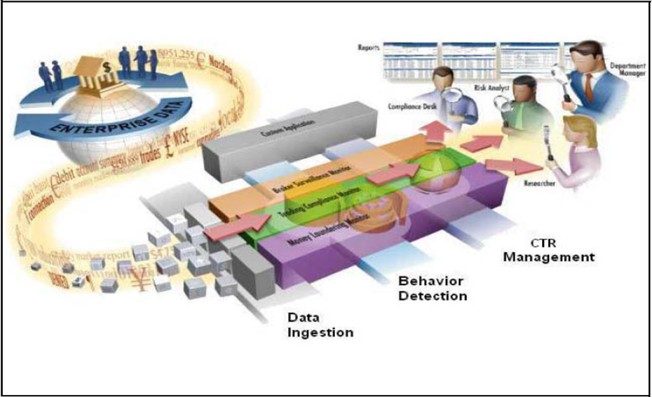2.2.1 Component View
This view describes the concept that a series of tiers and subsystems compose the Oracle Financial Services architecture. Each tier can contain all subsystems. Subsystems, in turn, include one or more components that are divided into small installable units. A solution set requires installation of the associated Oracle Financial Services architecture.
Figure 2-1 Oracle Financial Services Architecture - Overview

Each tier can contain all subsystems. Subsystems, in turn, include one or more components that are divided into small installable units. A solution set requires installation of the associated Oracle Financial Services components.
Tiers
The Currency Transaction Reporting solution has two tiers:
- The Behavior Detection Platform defines a foundation for building Currency Transaction Reporting solution sets. It provides core data mining services, frameworks, and tools. The application also includes interface packages that abstract non-standard or proprietary commercial off-the-shelf (COTS) products. Deployment of multiple Currency Transaction Reporting solution sets can occur on a single installation.
- Each Oracle Financial Services solution set (CTR, Fraud Detection and Anti-Money Laundering) extends the Oracle Financial Services framework. Each adds domain-specific content to provide the required services for addressing a specific business problem. It includes reusable domain artifacts such as scenarios, input data transformation code, and profiling scripts. A solution set also provides the required presentation packages and custom application objects for supporting user-interface functionality specific to the business domain.
Subsystems
The application is composed of the following subsystems:
- Data Ingestion: Provides data preparation logical functions, which include adapters for files and messages. The functions also include mappings for data derivations and aggregations.
- Behavior Detection: Provides data access, behavior detection, and job services, which include the Financial Services Data Model (FSDM) and scenarios specific to a particular solution set.
A set of components further divides each subsystem. Components are units of a subsystem that can be installed separately onto a different server. Table 2 outlines the definition for the subsystems and components. In some cases, however, individual deployments can add subsystems or components to meet a client’s custom requirements.
Table 2-1 Subsystemsand their Components
| Common Name | Directory Name | Contents |
|---|---|---|
| Data Ingestion | bdf | Java components, Informatica components,scripts, and stored procedures |
| Database Tools | database/db_tools | For DB tools directory |
| Detection Algorithms | algorithms | C++behavior detection algorithms |
| Scenario Manager | toolkit | Job and scenario editors |
| Financial Services Data Model | database | Database utilities and database creation scripts |